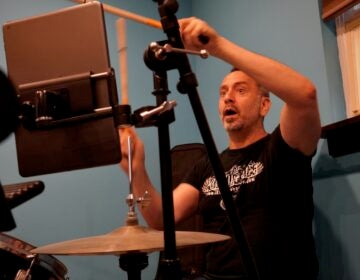Amtrak engineer will speak with NTSB investigators
Listen
Robert Sumwalt of the National Transportation Safety Board said the engineer of the Amtrak train that derailed Tuesday night will speak with investigators. (Tom MacDonald/WHYY)
The next step in the investigation into Tuesday’s fatal train accident in Philadelphia is the interview of the man driving the locomotive at the time of the crash.
The train’s onboard video camera shows the locomotive accelerating to more than 100 mph until seconds before the crash on a curve rated for only 50 mph, said Robert Sumwalt of the National Transportation Safety Board Thursday.
“Just before entering the curve, is when the engineer … induced braking to put it into emergency braking,” he said. “And I’ll describe it as seconds, mere seconds into the turn, we could see the train tilting approximately 10 degrees to the right, and then the recording went blank.”
The engineer of Amtrak 188 has agreed to an interview with investigators, Sumwalt said, which will give them a chance to hear his side of the story.
“I believe is a very good way of interviewing people is to honestly not ask questions, to give them a figurative blank sheet of paper and allow them to paint us a picture of what they recall and then we will start asking questions,” Sumwalt said.
NTSB investigators also are looking to see if the year and a half old locomotive had any previous problems.
Earlier Thursday, Philadelphia Fire Commissioner Derek Sawyer said a specially trained dog sniffed out the remains of an eighth person killed in the crash.
“We utilized our hydraulic tools to open the train a little bit more so that we can reach the person and extricate the person and have them transported to the medical examiners office,” Sawyer said.
Mayor Michael Nutter says the grim discovery effectively ends the days of tracking down each of the train’s 243 passengers and crew.
“All individuals that we had any reason to believe were on that train have now been accounted for and we know their whereabouts,” Nutter said.
Now the National Transportation Safety Board investigation can move ahead at full speed, along with the efforts to restore train service between New York and Philly. In addition to replacing track, Amtrak crews have to replace overhead wires, said Amtrak CEO Joe Boardman.
Some trains could be running again by Monday, with a full schedule more likely for Tuesday.
National Transportation Safety Board officials said Wednesday this crash could have been prevented if this stretch of track had a safety system in place known as positive train control.
PTC automatically slows a train going into the curve such as the one in Port Richmond where the train derailed. Boardman is vowing the system will be in place soon throughout the country.
“We spent $111 million getting ready for positive train control. We had to change a lot of things on the corridor to make it work,” he said. “We need some testing done on interference with the 220 megahertz radios that we are dealing with, but we will complete this by the end of the year.”
When PTC is in place, Boardman said, Amtrak will probably be the only railroad in Western Hemisphere to have it installed systemwide.
As for this crash, it could take a year to have a final report, and Philadelphia officials are not ruling out the possibility of criminal charges against the train operator.
WHYY is your source for fact-based, in-depth journalism and information. As a nonprofit organization, we rely on financial support from readers like you. Please give today.





